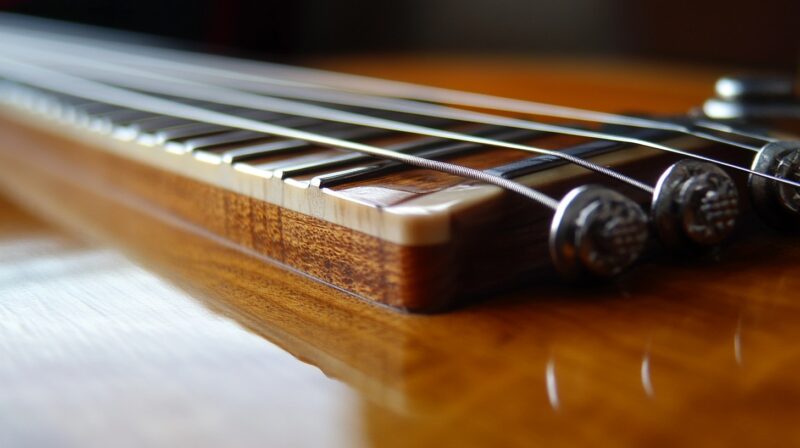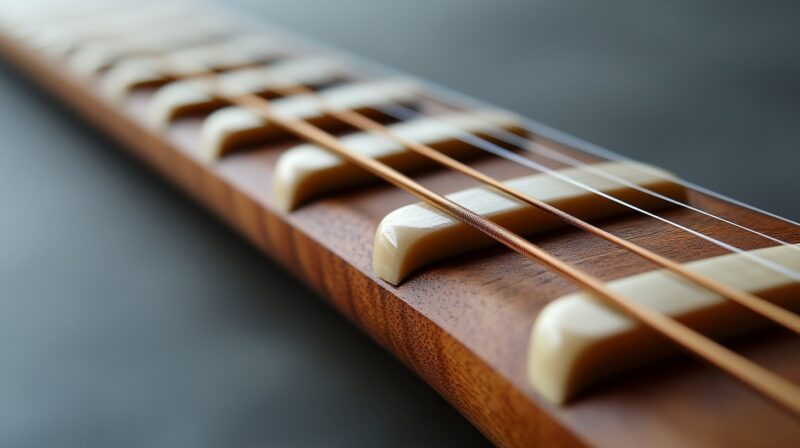A truss rod is a critical component in the anatomy of a guitar, essential for maintaining the instrument’s structural integrity and playability.
It plays a vital role in ensuring the neck remains straight and properly aligned, counteracting the tension caused by the strings.
Without a well-functioning truss rod, a guitar could suffer from issues like warped necks, high action, or fret buzz, all of which can significantly impair performance.
Understanding the function and maintenance of the truss rod is key to prolonging the life of your guitar and ensuring it remains in optimal playing condition.
Types of Truss Rods
Truss rods are a vital component of any guitar, providing the necessary support to maintain the neck’s integrity under the tension exerted by the strings.
- Single-action
- Double-action
Single-Action Rods
Single-action truss rods are the more traditional and widely used type. These rods have a simple design and are engineered to correct the neck in only one direction.
Typically, they are used to counteract the forward bow that naturally occurs due to the tension of the strings pulling on the neck.
The single-action truss rod works by exerting an opposing force to straighten the neck when it begins to bow forward.
Single-action truss rods have their limitations. They are particularly sensitive to environmental factors such as changes in humidity.
As the wood in the neck reacts to the environment—expanding in high humidity and contracting in dry conditions—the neck’s curvature can change, necessitating frequent adjustments.
This sensitivity means that guitars with single-action truss rods may require more maintenance, especially in climates with significant seasonal variations.
Despite this, single-action rods are highly effective for maintaining neck relief when used correctly and are a staple in many guitars.
Double-Action Rods
In contrast, double-action truss rods provide a more versatile solution.
These rods are designed to adjust the neck in both directions, correcting both concave and convex bowing.
This dual-adjustment capability makes them more stable and less susceptible to environmental changes.
Unlike single-action truss rods, which only push against string tension, double-action rods can both push and pull, offering more precise control over the neck’s relief.
This added control is particularly beneficial for professional guitarists and luthiers who require consistent performance from their instruments across various environments.
For example, a double-action truss rod allows for easy adjustments whether the neck is bowing forward or backward, ensuring that the guitar remains playable in a range of conditions.
This stability is especially important for touring musicians who may encounter different climates and need their instruments to perform reliably.
Truss Rod Adjustment

Adjusting the truss rod is a vital component of guitar maintenance, as it has a direct impact on both the neck’s curvature and the overall playability of the instrument.
he neck relief, or the subtle curvature of the neck, is essential for achieving the ideal string height, often referred to as the action.
Proper neck relief ensures that the strings are positioned at a comfortable height above the fretboard, which in turn helps to prevent common issues such as fret buzz, where the strings vibrate against the frets in an undesirable way.
Adjustments are typically necessary when the neck starts to bow either forward or backward, which can happen due to a variety of factors.
The most common causes include changes in string tension, such as when switching to a different gauge of strings, and environmental conditions like fluctuations in humidity.
As the wood in the neck expands or contracts with changes in moisture levels, the overall shape of the neck can shift, adjusting necessary to restore optimal playability.
Understanding when and why to make these adjustments is critical.
For example, if you notice that the action of your guitar has become too high, making it difficult to press down the strings, or too low, leading to fret buzz, it’s likely that the neck’s curvature has changed and needs to be corrected.
However, it’s important to dispel some common misconceptions about this process. One widespread myth is that adjusting the truss rod is primarily about altering the action.
While it does influence the action, its main role is to manage the neck’s relief, ensuring that the neck maintains the correct curvature for smooth playing.
How to Adjust a Truss Rod
Adjusting a truss rod requires careful attention and the right tools. The essential tools for this task include a wrench (usually Allen or hex), and it’s important to use the correct size for your guitar’s truss rod nut.
Once you’ve determined the neck’s curvature, you can begin the adjustment.
- For a concave neck: Tightening the truss rod will help to straighten it by applying pressure against the tension created by the strings. This is typically done by turning the wrench to the right—following the “righty-tighty” rule.
- For a convex neck: Loosening the rod will allow the neck to bow forward slightly, reducing the tension. This is achieved by turning the wrench to the left—following the “lefty-loosey” rule.
Once you’ve determined the neck’s condition, you can begin the adjustment process.
For a concave neck, tightening the truss rod (righty-tighty) will help straighten it by applying pressure against the string tension.
Conversely, if the neck is convex, loosening the truss rod (lefty-loosey) will allow the neck to bow forward slightly, relieving tension.
It’s important to make adjustments gradually, typically a quarter-turn at a time, and to check the neck’s condition after each adjustment.
Safety is paramount when adjusting a truss rod. Over-adjusting can cause irreversible damage to the neck or even break the truss rod.
If you’re unsure about the adjustment process or if the neck isn’t responding as expected, it’s advisable to seek professional help from a luthier or guitar technician.
Maintenance and Care

Regular truss rod checks are an essential part of guitar maintenance. How often you should check and adjust your truss rod depends on factors like climate and string gauge changes.
Seasonal adjustments are common, especially in areas with significant humidity variations.
During dry seasons, the neck may contract, requiring a slight loosening of the truss rod, while in more humid conditions, the wood may expand, necessitating a slight tightening.
Long-term maintenance of the truss rod involves ensuring it remains functional and effective.
Avoid forcing adjustments if resistance is felt, as this could indicate a problem. Regularly inspecting the truss rod nut for wear and ensuring it’s not stripped will help maintain its longevity.
Storing your guitar in a stable environment with controlled humidity can prevent drastic changes in neck relief, reducing the frequency of necessary adjustments.
Beginner Tip: Learn how to properly tune your guitar like a pro!
The Bottom Line
Understanding truss rods is vital for any guitarist who wants to maintain their instrument’s performance.
Regular checks and proper adjustments can prevent many common issues that affect playability.
By learning how to make these adjustments safely, guitarists are empowered to take control of their instrument’s setup, ensuring it remains in peak condition for years to come.
Related Posts:
- 13 Female Guitarists You Need to Know About in 2025
- The Biggest Music Tours to Watch in 2025 - What You…
- Financial Realities of Being a Young Musician - What…
- What You Need to Know About Sampling Music Without…
- What Guitar Accessories Do You Actually Need (and…
- Musicians and Their Unexpected Hobbies - 10…











